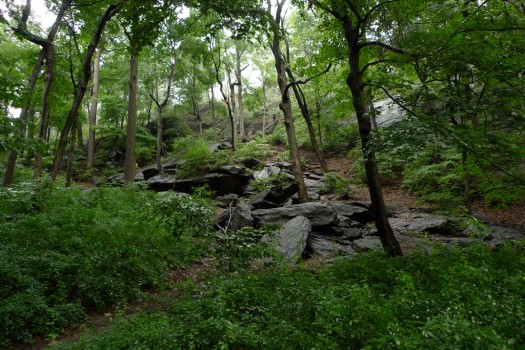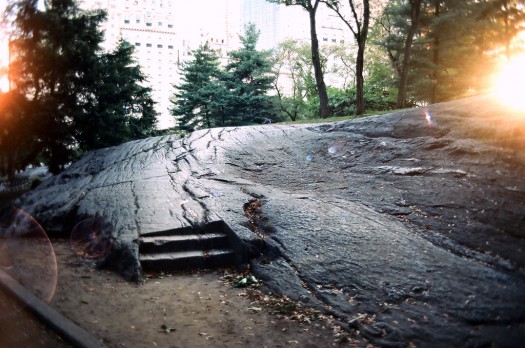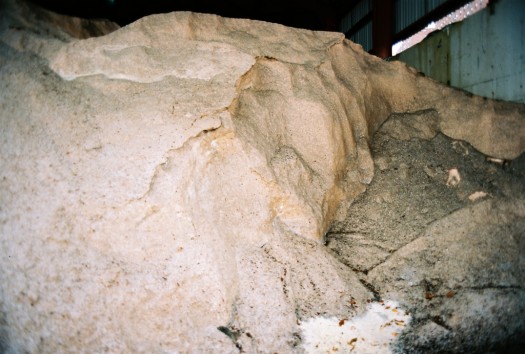
We are celebrating 15 years — and counting — of stories that are deeply researched and deeply felt, that build a historical record of what the city has been.
We are celebrating 15 years — and counting — of stories that are deeply researched and deeply felt, that build a historical record of what the city has been.
The built environment of New York City has existed for hundreds of years — an infinitesimal fraction of time on a geologic scale. But this recent blip of history during which we have produced our physical surroundings is inextricable from the millions of years that came before. “All geologic time is contemporary; all materials that we use to give form to the city have come to the present through deep geologic time.” This assertion guides Elizabeth Ellsworth and Jamie Kruse’s Geologic City: a Field Guide to the GeoArchitecture of New York City. Since August 2010, Ellsworth and Kruse have been posting “Geologic City Field Reports,” stories from their investigative voyages around the city, on their Friends of the Pleistocene blog. They will continue to research, explore and document the geologic forces around us into the first half of 2011, at which point they will design a printed field guide to complement the website that will invite and inform people to explore the city’s geology themselves. Here, Ellsworth and Kruse give us a taste of what they’ve discovered so far and help us comprehend the ways that deep geologic time is inscribed in the environments of our daily lives. –V.S.
The materials, colors, and textures that frame and fill our city streets — the very stuff that composes New York’s architecture and infrastructure — are not from the world we inhabit. They are from former worlds that existed millions of years ago, worlds as strange as any in science fiction.
Modern life and deep geologic time are profoundly embedded within one another, with great consequence for both the present and the future. Humans are not only intimately living with — and rapidly using up — geologic material that took scores of millions of years to create, we are also laying down a new and utterly unique stratum on the earth. It’s made up of human-made materials (including waste), and it will remain as one of earth’s geologic layers long after our species is gone. This has led some geologists to declare that we’ve entered a new geologic epoch. And they’ve named it after us: the Anthropocene.
Our work in progress, Geologic City: A Field Guide to the GeoArchitecture of New York, aims to visualize the vast, complex story behind this news. It’s a story that most people can’t begin to fathom, or at least they haven’t yet tried. With a Geologic City printed field guide in hand, residents and visitors will be able to interact with familiar New York architecture and infrastructure in an unexpected way: they’ll be able to see for themselves how forces of deep time give form and materiality to the built environment of the City.
Take, for example, Brooklyn’s celebrated brownstones. Made of red sandstone from the Triassic, they are nothing less than four-story-tall blocks of solid geology, 250 million years old. That’s pre-dinosaur. Rockefeller Center elevates and displays — 872 feet into the air — 340 million-year-old limestone that materialized during the middle Mississippian Period. And the geologic memory of the iron in the Manhattan Bridge predates Earth itself (it arrived here from a supernova to help form Earth 4.6 billion years ago).
Some people argue that humans are cognitively (evolutionarily) unable to imagine deep time. We disagree. So, for Geologic City, we’ve been trying not only to imagine deep geologic time, but also to recognize that our city is built on and of materials of deep time. What if artists and designers could help us recalibrate our capacities to comprehend geologic time? What if everyone did what geologists do: stretch imaginations to recognize the world around us as made out of the stuff of worlds that preceded us?
Our project is still very much in the works. But we’re far enough along to take you on a brief tour of a few sites that exemplify, as well as shake up, the premises of Geologic City.
.
GEOLOGY IN THE RAW

A rock slide in Inwood Hill Park, induced by glacial activity during the Pleistocene (10,000+ years ago).
Just over 10,000 years ago, Pleistocene-epoch glaciers scoured the face of Manhattan Island during their retreat. They scraped it down to its bones, also known as Manhattan schist, a geologic infrastructure of bedrock whose solid support makes it possible to build skyscrapers on the island. The marks are still clearly visible in the city today.
In Inwood Hill Park — where we kicked off Geologic City last August by taking a geology walk led by the esteemed New York urban geologist Sidney Horenstein — you can find the City’s largest glacial pothole, carved when pieces of rock, swirling in those turbulent melt waters, drilled holes into the surrounding stone. The same glaciers smoothed outcroppings of schist at the south end of Central Park, where today people picnic and lounge on their table-like surfaces.
A month after the Inwood geology walk, we set out to find one particular Central Park schist outcropping, incised with two simple steps — to us, one of the more exquisite conjunctions of the human and geologic in New York City. The stairs caught our attention when we happened upon Robert Smithson’s 1973 Artforum essay “Frederick Law Olmsted and The Dialectical Landscape.” Smithson illustrated his essay with several photographs of the Park, including one captioned, simply, “Rock Stairs 1972.” We wondered if, 40 years later, the stairs could still be found. We spotted them just north of 59th Street.

Manhattan Schist rock stairs (450 million years old), designed by Olmsted and Vaux in Central Park, as photographed by Robert Smithson in 1972.
An historian at the Central Park Conservancy told us the steps were part of the original park plan and can be credited to the designers themselves, Olmsted and Vaux. For a century and a half, these steps have made a 450 million-year-old piece of rock “active” through their poetic futility. A sidewalk runs right alongside the gently sloping stone, which means the stairs don’t provide “passage” or assistance in climbing as much as they offer a shift in being. By “using” the geoarchitecture afforded by these stairs, New Yorkers today accept an invitation to make direct contact with the geology of the City. The stairs politely suggest that we break from the predetermined route of the sidewalk and head up and onto the open space of bare geologic materiality. What happens next is up to us.
.
REMIXED GEOLOGICAL STRATA OF THE FUTURE
In October, we took a public tour of the Fresh Kills landfill. We found ourselves standing on a grassy mound, elevated to almost 200 feet by the pile of trash beneath us. As long as funding continues, a park three times the size of Central Park will be completed there by 2036. The “hills” that create the foundation of the proposed recreation area stand in sharp contrast to the schist foundation of Central Park. Because Freshkills Park is being constructed on a foundation of garbage — 53 years worth of city trash to be exact — the site is unsuitable for heavy construction (such as that required for the once-considered wind farm). So, the park will offer light-use activities such as mountain biking and trail running.
Within the hills, one human-made “geologic stratum” enfolds another as the mounded garbage layer is capped and contained by a layer of impermeable plastic. Beneath the plastic cap, the environment is airless, or anaerobic. That means a discarded hot dog will remain preserved, as is, for decades beyond our individual lifetimes. Plastic garbage, which is inorganic, will never decompose here or anywhere. It will merely break down into smaller and smaller bits of itself. Which led us to think that, in 2,000 years, Freshkills Park might be known as a geologically rich site for discovering concentrations of plastic, not so dissimilar to today’s concentrations of coal, uranium or oil.
.
EPHEMERAL GEOLOGY

Miocene salt (8+ million years old), also known as rock salt, in temporary storage under the Manhattan Bridge.
One afternoon in early autumn, we found ourselves standing under the Manhattan Bridge in the rain, confronted with several thousand tons of geologic materiality. To the Department of Sanitation, the material is known as rock salt. To us, the elephantine heap of salt was an ephemeral urban sculpture — an installation of deep time on view to select employees of the DSNY.
The salt travels here via International Salt, the City’s supplier, from the Tarapacá Salt Flats in Chile, vast deposits inside ancient sea beds that now lie in the driest desert in the world (50 times drier than Death Valley). Despite having materialized 8-10 million years ago during the Miocene epoch, the tons of solidified geologic time piled beneath the bridge will dissolve away in a matter of weeks as they are spread atop hundreds of miles of wintry city streets. Before washing away with spring rains, this thin coating of ancient salt will first encrust nearly every exterior surface of the city — roads, sidewalks, bikes, cars, and shoes — with traces of deep time.
.
TRACE GEOLOGY ON THE MOVE
Uranium, element 92 on the periodic chart, is literally otherworldly. It formed in pre-Earth times in supernovae about 6.6 billion years ago. Today, on an exposed edge of Staten Island, cosmic time, deep geologic time and contemporary human time (the Anthropocene) remix wildly in the material form — and continuing flows — of uranium.
In 1938, a three-story Archer Daniels Midland Company warehouse stored vegetable oil in 2377-2387 Richmond Terrace, Staten Island, in the shadow of the Bayonne Bridge. But that year, the building took on a new purpose when a ship arrived from the Belgian Congo — where significant amounts of uranium concentrated in the rock of the Shinkolobwe mine (located in contemporary Democratic Republic of the Congo) sometime in the late Proterozoic (570-900 million years ago) — and unloaded 2,007 steel drums containing 1,200 tons of raw uranium ore. This uranium would soon became part of the nuclear infrastructure known as the Manhattan Project, when it was used to create the atomic weapon that was dropped over Hiroshima.
In 1980, according to the Metropolitan Waterfront Alliance, representatives from the Oak Ridge National Laboratory found dangerously high levels of radioactivity in Richmond Terrace. But nothing was done. In 2008, citizens called on the Environmental Protection Agency to investigate the contamination. The EPA recorded levels of uranium radiation more than 200 times what is required to trigger a cleanup. Remarkably, the site is exposed directly to an active waterway, the Kill Van Kill, a tidal strait that runs between Staten Island and New Jersey.
Today, there’s little to see along this stretch of Richmond Terrace. A couple of abandoned trailers and a pile of old tires litter a partially vacant lot used by a local paving company. The gate was open on the day we visited. We walked in and took a look around. Any signs of active remediation were invisible to us. The US Army Corps of Engineers began evaluating the location in January 2010. An April 2010 report from NY1 describes the cleanup, more than 70 years after the arrival of the uranium, as still being in the “preliminary assessment” stage.
.
GEOLOGIC FUTURE
It seems that creative works made in response to geologic time are becoming more common. Maybe this means that human capacities to design, imagine, and live in relation to deep time are about to take an evolutionary leap. In the meantime, we’re designing Geologic City as an aesthetic prosthesis — a speculative tool — that New Yorkers can use to activate their imaginations in relation to deep time as they move through New York City.
As our research continues in 2011, we will respond to the geologic materiality of yellow cab paint; hydro turbines in the East River; and we’ll look a bit offshore at the convergence of geology and fiber optic cables in the Hudson Canyon.
We will also explore how we humans factor into the Geologic City — as geologic material ourselves. Humans are carriers of geologic elements: always in motion, we augment and intensify the materials, flows, and remixings of the city’s geologically-based architectures and infrastructures.
We want to invent ways to communicate visually how New York’s geologic materials and meanings flow and transform across worlds that have been and worlds yet to come. We want to ignite a renewed, or perhaps altogether new, appreciation for the materialities of deep geologic time as well as for the infrastructures that channel and consist of them.
.
Full Geologic City field reports can be read on the Friends of the Pleistocene blog:
Introduction
1. Pre-Earthian New York City: Inwood Hill and Fort Tryon Park
2. Forces Beyond Time: Shinran Statue
3. Staten Island’s Tainted Edge: 2377-2387 Richmond Terrace
4. Stepping into Time: Rock Stairs
5. A Portal into the Present: Newtown Creek Nature Walk
6. Monument to the Miocene: Rock Salt Warehouse
7. From the Top of the Heap: Freshkills Park
8. Urban Infrastructure as Geologic Material in Motion
9. El Dorado Found: 33 Liberty Street
The views expressed here are those of the authors only and do not reflect the position of The Architectural League of New York.
Comments